

Imperial Home Page -> Imperials by Year -> 1958 -> Punch Card, Build Record Sheet, and Dataplate Decoding
1958 "Chrysler Historical" Punch Card, Build Record Sheet, and Dataplate Decoding …
This was only doable thanks to Philippe Courant, Chrysler Historical, the Online Imperial Club and the Forward Look Network.
Index
0 Introduction & pre-requisites
1 Reading the punch card and the dataplate
1.1 Reading the punch card
1.2 Reading the dataplate
2 Decoding the punch card and the dataplate
2.1 Decoding the punch card
2.1.1 The main information about the car model, paint and upholstery
2.1.2 The options
2.2 Decoding the dataplate
0 Introduction & pre-requisites
First thing to do is to order your build sheet record at Chrysler Historical. The amount they ask is not very high, and this will provide you with what I call the “certificate of birth” of your Mopar automobile. Please refer to the Chrysler Historical website for the availability and ordering process.
Once you receive the answer from Chrysler Historical, you should get in an envelope, a copy of your build record sheet, also named “punch card”, and the decoding Chrysler Historical did.
1 Reading the punch card and the dataplate
1.1 Reading the punch card
The card contains each piece of information twice.
What is printed and typed has a correspondent punch hole or series of punch holes.
Below, you can find mine, which is interesting as it’s from a car that was exported new to France. Therefore, it contains a lot of oddities.
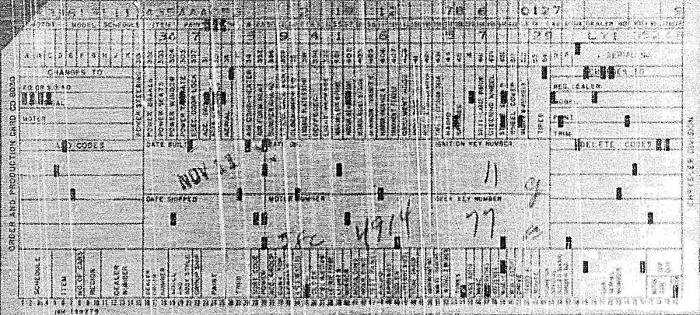
You will notice also that sometimes, the quality is extremely poor, as this depends on the way the card was microfilmed by Chrysler. Some are perfectly clear, others are a nightmare to read.
The printed and typed information:
What is printed is in fact the “template” of the punch card: it’s like a big table with many fields. In the available empty cells, the corresponding options were typed. It’s one digit only, and can complement a 2-digit option – like the “5” typed above the 44 option field (radio) making it the option 445, or it can simply be the last digit of the option – like 3 above the 303 option field (power seats, the option is thus coded 303 , and not “3033”).
Deciphering the holes:
This is in fact easy to do. It reads from left to right (by columns) and from top to bottom.
As one can see, there are rows of holes, the last row at the bottom corresponding to the “9” digit. So, from bottom to top, it’s row “9” to row “0”. Above the row “0”, there are two other rows, usually used to code letters options (like the paint code).
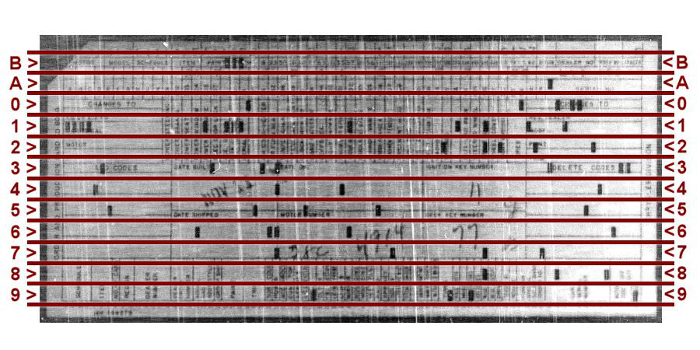
Then, each hole matches a column. These columns are numbered from 1 to 80: you can see those digits at the very bottom of the punch card in a very small font.
Example: the first four columns (1 to 4) correspond to the Schedule date, which is 1111. That is shown by the 4 consecutive punch holes on row “1”.
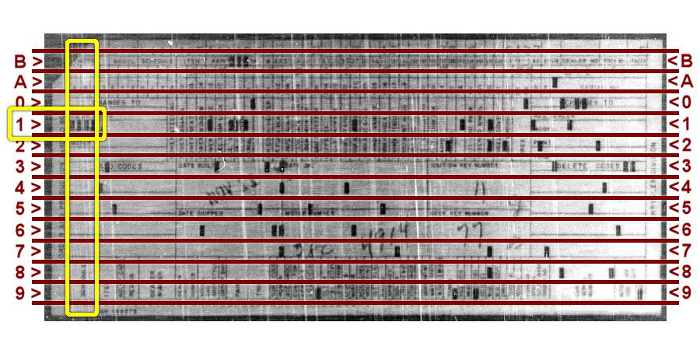
With a ruler and some patience, one can then decipher all the holes. Regarding the paint and serial number, it’s a combination of holes in different rows. Here, only the study of several cards of different cars could tell what letter corresponds to which holes (reverse engineering is required).
1.2 Reading the dataplate
Part of the information one can see on the punch card is replicated on the dataplate that is installed on the radiator core, one the right side of the car (on your left if you look to the car from the front). Below is a BLANK Data Plate layout, before the various codes, paint, and trim, etc. are filled in.
The “template” of the 1958 dataplate is:
MDL SCDL ITM PNT TRM
3333H4J4L3L5344M3NP4444RS3T
0000 1 2 3 2600 4 0006 0
SRL FOSO 5ABCDEF3343534G3
6 2940093 6
The first row shows the following information: it reads horizontally.
Second row shows the first “lot” of options: it reads vertically.
Third row shows other options on the part on the right, which reads vertically, plus two other pieces of information:
2 Decoding the punch card and the dataplate
2.1 Decoding the punch card
Regarding the codes, there are 4 main zones, as depicted in the picture below:
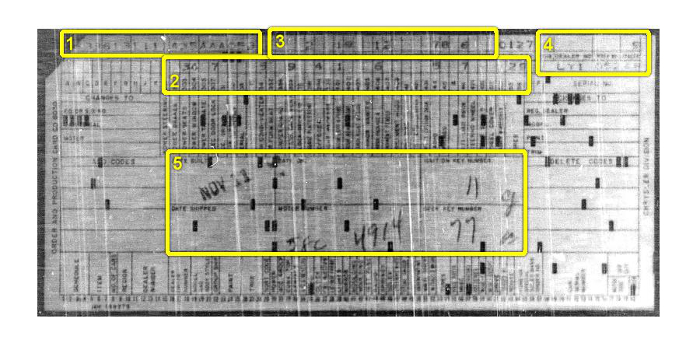
2.1.1 The main information about the car model, paint and upholstery
On the top left corner (zone “1”), you find the codes you will find as well on the dataplate that is attached to your radiator core. From left to right, the codes are:
1 – The engine, for a domestic or export car with the standard compression ratio (10:1) is 632. Engine with the 8:1 compression ratio is coded 633.
|
10:1 compression ratio engine |
632 |
|
8:1 compression ratio engine |
633 |
2 – The model code (MDL on the dataplate) will depend on your car series and body style:
|
|
LY1-L |
LY1-M Crown |
LY1-H LeBaron |
|
2-door hardtop coupe |
612 |
632 |
N/A |
|
4-door sedan |
613 |
633 |
653 |
|
4-door hardtop sedan |
614 |
634 |
654 |
|
2-door convertible coupe |
N/A |
635 |
N/A |
3 – The “schedule” field (SCDL on the dataplate) tells you the day the car was scheduled to be built. It’s the calendar date. For instance 1212 means 12th of December (1957). 0601 means 1st of June (1958). On mine, the car was built the day it was scheduled to be built, i.e. Monday 11th of November, 1957.
4 – The item code (ITEM on the dataplate) is a mystery. However, one guess is that it could mean the sequence number in the production plan: for instancer, item 435 and SCDL 1111 could mean 435th car scheduled that day (11th of November).
5 – The paint code (PNT on the dataplate) tells you the color your car was painted. The letters correspond to the paint chips you can find for sale. The first letter indicates the roof color, the middle letter tells the upper body section, and the last letter tells the lower body color.
|
AAA |
Raven Black |
|
BBB |
Stardust Blue |
|
CCC |
Air Force Blue Poly |
|
DDD |
Midnight Blue |
|
EEE |
Spring Green |
|
FFF |
Cypress Green Poly |
|
GGG |
Mandarin Jade Poly |
|
HHH |
Aztec Turquoise |
|
JJJ |
Spruce Green Poly |
|
KKK |
Satin Grey |
|
LLL |
Winchester Gray Poly |
|
MMM |
Mesa Tan |
|
NNN |
Sandalwood Poly |
|
OOO |
Tahitian Coral |
|
PPP |
Matador Red |
|
RRR |
Shell Pink |
|
TTT |
Garnet Maroon Poly |
|
UUU |
Bamboo Yello |
|
WWW |
Ballet Blue |
|
XXX |
Ermine |
|
ZZZ |
Champagne Gold |
|
? |
Special paint order |
6 – The trim code (TRM on the dataplate) tells you the upholstery installed in your car.
LY1-L: "Diamond Glow", Jacquard cloth with metallic vinyl bolsters.
LY1-M (Crown): "Monaco", medium tone "crown" pattern cloth with light tone bolsters, broadcloth for sedans and metallic leather for Southamptons. Optional full leather upholstery.
LY1-H (LeBaron): soft, smooth wool broadcloth.
|
|
|
Shades |
||||
|
Model |
Body style |
Blue |
Green |
Tan |
Silver |
Red |
|
LY1-L |
sedan (std) |
050 |
051 |
052 |
053 |
N/A |
|
hardtops (std) |
054 |
055 |
056 |
057 |
N/A |
|
|
LY1-M |
sedan (std) |
088 |
089 |
090 |
091 |
N/A |
|
hardtops (std) |
058 |
059 |
060 |
061 |
N/A |
|
|
hardtops (opt) |
083 |
084 |
085 |
086 |
087 |
|
|
LY1-H |
any |
062 |
063 |
064 |
065 |
N/A |
Cars with a special trim ordered by the customer show a trim coded 888.
2.1.2 The options
Like on the dataplate, the options are typed on the punch card. That is what you can read in the upper center section (zone “2”). Some rather rare options may not be there, and rather typed elsewhere (zone “3”), like the option 306 (kilometer speedometer) that is not next to the more “common” options.
2.1.3 Other information
As you can see, the card also has several other types of information:
Serial number:
It contains the full serial, including the “LY1” that all serial numbers start with.
The dealer information:
There are 2 fields on the top corner. The “Region” (for instance, 90 is for Canada) and the Dealer code. Export cars (outside US and Canada) are likely to have empty fields there, like on mine.
Special Order information:
This is an incremental number, and as far as we can guess, it tells that the car came with something special: export model, special paint, special upholstery or something else that wasn’t "standard". For instance, Imperial serial #5248 came with FOSO #0127 (export car), Imperial #4005 came with FOSO #0089, due to a likely forbidden color combination (Garnett Maroon paint "TTT" with a Green interior "059". Quite odd, isn't it?). There is however another Imperial with a FOSO number showing "C843". Would this be a typo? Would FOSO code also have letters? Only a copy of the its punchcard will tell.
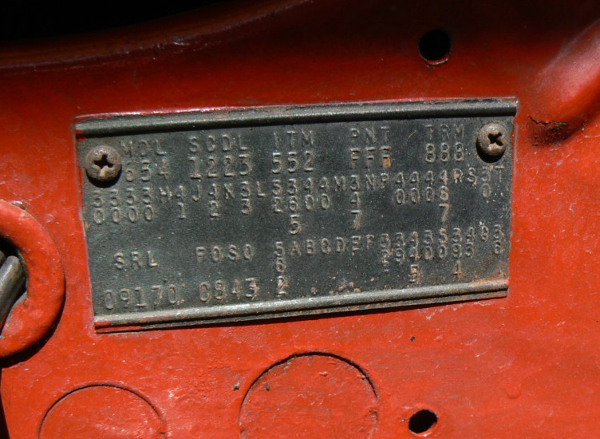
Export codes:
Cars exported outside US and Canada got special options, such as 591 for Export Tool Kit or 592 for Tubeless Tire Repair Kit. These are typed on the top center section (zone “3”).
Other options or standard equipments:
Even if they are not on the dataplate, the punch card contains much more information, such as the axle ratio, the “drive” code (car’s destination: domestic or export), the convertible top color, the generator type, the tires and so on …
Below you can find a summary of those options. The list may not be complete.
|
Group |
Title |
Code |
Real meaning in real life |
|
|
30 |
Power |
303 |
Power Seats |
|
|
304 |
Power Windows |
|||
|
306 |
Kilometer speedometer |
|||
|
307 |
Power Door Locks |
|||
|
32 |
Convertible top color or rear speaker |
321 |
Black top |
|
|
322 |
White top |
|||
|
323 |
Blue top |
|||
|
324 |
Green top |
|||
|
327 |
Rear speaker (except convertible) |
|||
|
33 |
Aerials |
334 |
Power Antenna |
|
|
34 |
A/C & heaters |
341 |
A/C, rear unit |
|
|
342 |
A/C, Deluxe, double unit |
|||
|
345 |
Custom Conditionaire heater |
|||
|
347 |
Instant Heater |
|||
|
35 |
Misc. |
359 |
Crankcase ventilation (export) |
|
|
36 |
Clock |
365 |
Flitesweep Decklid |
|
|
38 |
License Frame |
381 |
Licence plate frame (front) |
|
|
39 |
Lights |
394 |
Rear defogger (except convertible) |
|
|
397 |
Auto-Pilot cruise control |
|||
|
399 |
Sure Grip differential |
|||
|
40 |
Mirrors |
401 |
Left front rearview mirror (manual) |
|
|
402 |
Left front rearview mirror (remote) |
|||
|
403 |
Right front rearview mirror |
|||
|
405 |
Vanity mirror |
|||
|
406 |
Accessory Package A |
|||
|
408 |
Hood ornament |
|||
|
44 |
Radio |
445 |
Electro-Touch radio w/ power antenna |
|
|
46 |
Solex |
467 |
Solex tinted glass with shaded windshield |
|
|
53 & 54 |
Tires |
|
531+549 and 532+549 mean 5 Rayon 9.50x14 whitewall tires. |
|
|
55 |
Axle Ratio |
551 |
2.93 to 1 |
|
|
57 |
Generator |
579 |
30 AMP generator |
|
|
59 |
Export / Misc. |
591 |
Export Tool Kit |
|
|
592 |
Tubeless Tire Repair Kit |
|||
|
597 |
Lower Compression Engine |
|||
|
598 |
Firm Shock Absorbers – front & rear |
|||
|
61 |
Drive |
611 |
Domestic |
|
|
612 |
Export |
|||
Engine number:
This field is critical to verify that a car is a “matching number” or not.
Date built and Date shipped:
The built date tells the day the car was built. Here, it matches the day the car was scheduled (11th of November, 1957). Then, usually, one should find the date the car was shipped. Here, on this export model, the date is missing. Why, we do not know. Perhaps because it was an export model, it followed a special process (indeed, how to ship to some place when at the same time, dealer and region codes are missing …).
Additional clarification of Punch Card from Club Member Bill Watson from Toronto, ON, Canada:
If the first two digits of the engine code are "63", It is coded on the 77th, 78th and 79th columns (one column per digit, like the serial number)
The column numbers across the bottom of the card form the first two digits of the sales code. The first and last sections are usually used for SO Number, dealer, colour and trim details as well as the serial number. The hole rows go from 9 at the bottom to 0 almost at the top. There are usually three rows above the zero as well and are usually used when a column is used to record letters. Some columns, such as the one labelled "Power Equipment", may have more than one hole punched.
If, for example, power steering is 321, power brakes 322, power windows 323, power door locks 324, and power antenna 328, and your car has all five options, column 32 will have holes 1, 2, 3, 4, and 8 punched.
The upper section of the card has small columns, all labelled and numbered. The ones with a number on the top of the description form the sales code for equipment installed on your car.
Just to break the boredom, the IBM cards back then varied from plant to plant, thus a 1958 Plymouth card from Detroit (Lynch Road Plant) is different from a 1958 Dodge from Detroit (Hamtramck Plant)
2.2 Decoding the dataplate
The dataplate is filled with codes that denote the options (and not the standard equipments). For instance, a Crown would not show the power windows code as they were standard. Compared to the punch card, the dataplate looks like a “summary”.
Here is one (mine):
MDL SCDL ITM PNT TRM
613 1111 435 AAA 053
3333H4J4L3L5344M3NP4444RS3T
0000 1 2 3 2600 4 0006 0
43 7 5 67 6
SRL FOSO 5ABCDEF3343534G3
05248 0127 6 2940093 6
5
The first rows decodes as the punch card.
The second row here shows the following options (from left to right): 304,303,307,345,406,467,306. The codes are the same as on the punch card.
The third row shows the serial number and the FOSO number, and one additional option, 445. It decodes as on the punch card.
Also Thanks to Bill Watson for his helpful ongoing contributions to the ImperialClub website.
To view Frederic's Imperial as described on this page, please click here.
This page was last updated January 2022. Send us your feedback, and come join the Imperial Mailing List - Online Car Club